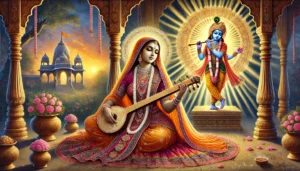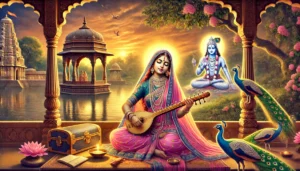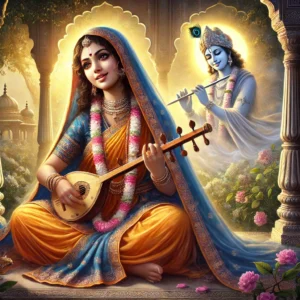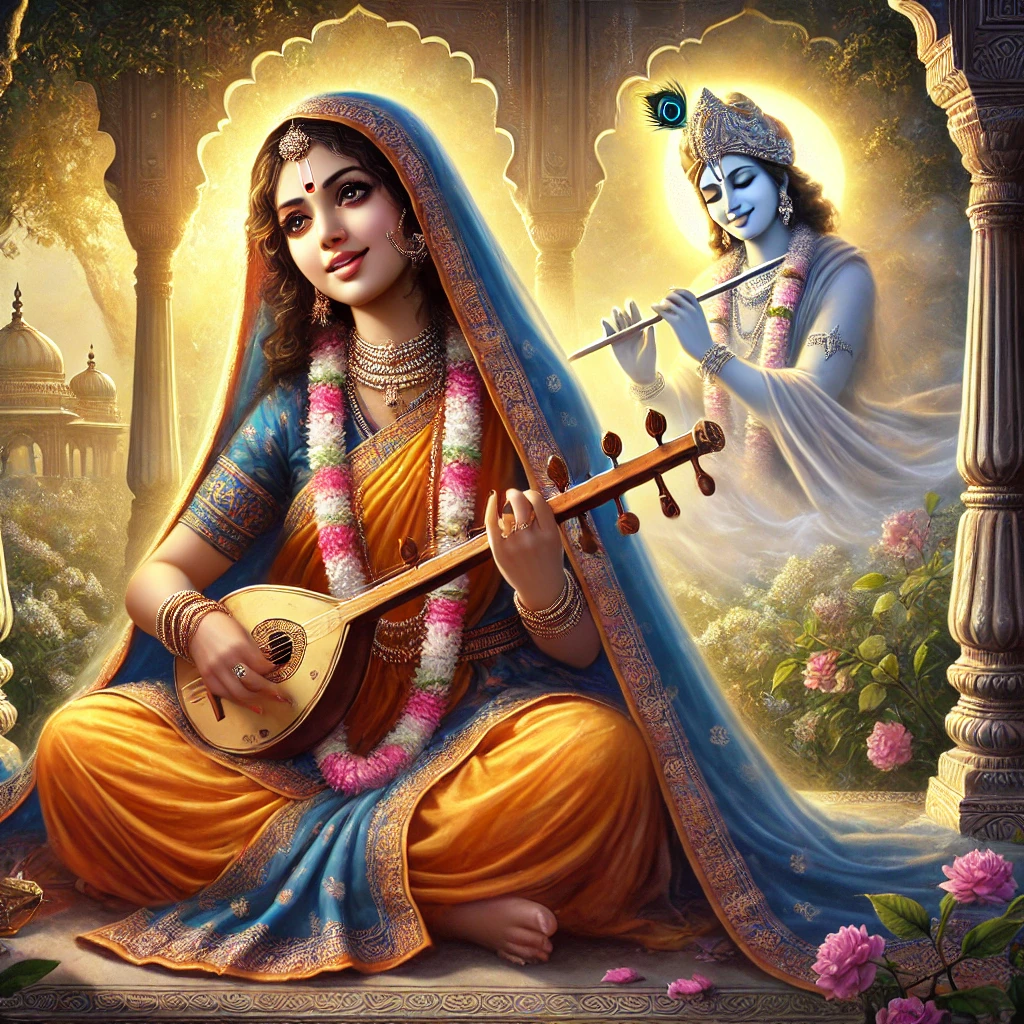
Meera Bai The Eternal Devotee of Krishna
Meera Bai: The Devotee and Her Divine Love for Krishna
Meera Bai, the iconic saint-poetess of medieval India, embodies the timeless ideals of devotion, spiritual courage, and selfless love. Her life, which revolved around an unwavering dedication to Lord Krishna, transcends cultural and religious boundaries, making her a symbol of universal spirituality. Born into the royal Rathore family of Merta, Rajasthan, in 1498, Meera’s story is a fascinating interplay of devotion, defiance, and divine surrender.
Early Life: A Devotee in the Making
Meera was introduced to the idea of Krishna’s divinity at a young age. Legends recount that as a child, she witnessed a wedding procession and innocently asked her mother who her husband would be. In response, her mother pointed to an idol of Krishna and said, “He is your husband.” This incident left a profound impression on Meera’s tender mind, and from that moment, Krishna became the center of her life.
Despite being born into royalty, Meera’s heart longed not for worldly riches but for the spiritual treasure of Krishna’s love. Her devotion was nurtured through songs, dances, and hours spent in worship. This deep spiritual connection would later define her entire existence, leading her to question the constraints imposed by societal norms and familial obligations.
Marriage and the Spiritual Dissonance
Meera was married to Rana Bhojraj, the prince of Mewar, in a union intended to strengthen political alliances. However, the marriage did not deter her devotion to Krishna. Meera considered herself Krishna’s bride, and her mortal marriage held little significance compared to her divine union.
Her husband, though initially supportive, eventually struggled to reconcile Meera’s intense spiritual practices with the expectations of royal decorum. She would often sing and dance in temples, completely absorbed in her love for Krishna, which became a source of tension within the royal household. Despite these challenges, Meera remained steadfast, refusing to compromise her devotion.
Table of Contents

Trials and Tribulations: The Path of a True Devotee
Meera’s journey was far from easy. Her in-laws, particularly her brother-in-law Vikramaditya, saw her spiritual practices as a threat to the family’s honor. Tales of her devotion spreading among commoners, her interactions with ascetics, and her disregard for caste and gender hierarchies were unacceptable in a patriarchal and hierarchical society.
Legend has it that several attempts were made to harm her, including offering her a poisoned drink and sending her a basket containing a deadly snake. However, each attempt failed miraculously, strengthening her faith and the belief of her followers in Krishna’s divine protection. For Meera, these trials were not obstacles but opportunities to demonstrate her unwavering faith.
Eventually, the mounting pressures and hostility forced Meera to leave the royal palace. Renouncing her royal identity, she embarked on a journey as a wandering saint, singing the glories of Krishna and inspiring countless people with her devotion.
The Poetry of Divine Love
Meera’s legacy is immortalized in her bhajans, which form a cornerstone of the Bhakti movement. Her poetry is a profound expression of her love and longing for Krishna. Written in simple yet deeply evocative language, her verses resonate with emotions that are universal and timeless.
Her compositions often describe her relationship with Krishna in the language of a lover yearning for union with the beloved. This metaphor of divine love as human love was a hallmark of the Bhakti tradition and made spirituality accessible to the masses. Her songs also reflect themes of surrender, sacrifice, and the transcendence of worldly attachments.
Some of her most famous bhajans include:
“Mane Chakar Rakho Ji” – A plea to Krishna to accept her as his eternal servant.
“Paayo Ji Maine Ram Ratan Dhan Paayo” – A joyous declaration of having attained the spiritual wealth of Krishna’s love.
“Mere To Giridhar Gopal” – A powerful affirmation of Krishna as her sole refuge and companion.
Her poetry is celebrated not only for its devotional fervor but also for its artistic brilliance. Sung in temples, homes, and spiritual gatherings, her bhajans continue to inspire devotion and provide solace to millions.
Meera’s Influence on the Bhakti Movement
The Bhakti movement, which emerged as a response to rigid religious orthodoxy, emphasized personal devotion and love for God over rituals and caste-based hierarchies. Meera Bai was one of its most prominent figures, breaking barriers of caste, gender, and status to propagate the ideals of bhakti.
Her life and works challenged societal norms, particularly the subordinate role of women in spiritual and public life. In a time when women were often confined to domestic roles, Meera stood as an example of spiritual freedom and individuality. She became a beacon of hope for those marginalized by society, proving that devotion transcends all worldly distinctions.
Journey to Dwarka: The Final Union
Toward the end of her life, Meera traveled to Dwarka, the sacred city associated with Krishna. It is believed that she merged into the idol of Krishna in the temple of Dwarkadhish, signifying her ultimate union with her beloved. This event is seen not as her death but as her eternal liberation and fulfillment of her divine love.
Legacy of Meera Bai
Meera Bai’s life and devotion continue to inspire people across the world. Her unwavering love for Krishna, her poetic genius, and her courage to defy societal norms make her a timeless figure. In modern times, she serves as an icon of spiritual freedom, reminding us of the power of faith and the importance of following one’s heart.
Her story teaches us that true devotion requires courage, resilience, and surrender. Meera’s love for Krishna was not confined to temples or rituals; it was a way of life, a path that led her to ultimate liberation.
As we sing her bhajans and reflect on her life, we are reminded of the boundless joy and peace that come from connecting with the divine. Meera Bai’s legacy is a call to transcend the limitations of the material world and embrace the eternal bliss of divine love.

Meera Bai The Eternal Devotee of Krishna
Conclusion
Meera Bai’s life is a timeless celebration of faith, love, and devotion. Her journey from a royal palace to a life of renunciation and spiritual freedom reflects the transformative power of divine love. In her bhajans, we find not just a devotion to Krishna but a roadmap to inner peace and universal love.
Meera’s life reminds us that when the soul seeks the divine, no obstacle is insurmountable. Her story continues to inspire generations to follow the path of love, courage, and spiritual awakening.
FAQs for “Meera Bai: The Eternal Devotee and Her Divine Bond with Krishna”:
- Who was Meera Bai?
Meera Bai was a 16th-century saint, poet, and princess from the Rajput kingdom of Mewar in Rajasthan. She is renowned for her devotional songs dedicated to Lord Krishna, her unwavering spiritual commitment, and her fearless defiance of societal restrictions.
- Why is Meera Bai considered a symbol of devotion?
Meera Bai’s life was a testament to the purity and intensity of Bhakti (devotion). She dedicated her entire existence to Krishna, embracing a path of unconditional love and surrender, regardless of the hardships and opposition she faced.
- What is unique about Meera Bai’s devotion?
Meera Bai’s devotion to Krishna was personal and intimate. She viewed Krishna as her husband, beloved, and spiritual guide, dissolving all boundaries between herself and the divine. Her spiritual connection transcended ritualistic practices, focusing solely on love and surrender.
- What challenges did Meera Bai face in her spiritual journey?
As a member of a royal family, Meera faced resistance from her in-laws and society due to her public display of devotion to Krishna. She was ostracized, accused of bringing dishonor, and even faced attempts on her life, including poisoning. However, she remained steadfast in her faith.
- What are some key themes in Meera Bai’s poetry?
Divine Love: Expressing her longing for union with Krishna.
Detachment: Renouncing worldly ties and material pleasures.
Surrender: Total submission to Krishna’s will.
Struggles of Devotion: Overcoming opposition and challenges in her spiritual journey.
- What is the historical significance of Meera Bai’s life?
Meera Bai’s life marked a significant moment in the Bhakti movement, which emphasized personal devotion over ritualistic worship. Her poetry and defiance of social norms challenged the patriarchal systems of her time.
- How did Meera Bai’s devotion influence the Bhakti movement?
Meera Bai became one of the central figures of the Bhakti movement, inspiring countless people to seek a direct, emotional relationship with God. Her life and works showed that devotion transcends gender, caste, and societal status.
- What is the central message in Meera Bai’s songs?
Meera’s songs convey the message of unconditional love, surrender, and devotion to the divine. They emphasize that the ultimate purpose of life is union with God, achieved through love and dedication.
- Did Meera Bai follow any specific religious practices?
Meera Bai’s devotion to Krishna was rooted in the Bhakti tradition, which prioritizes personal connection with the divine over rituals. Her practices involved singing, dancing, and composing poetry in praise of Krishna.
- Why did Meera Bai leave her palace?
Facing persecution and constant opposition from her royal family, Meera Bai eventually renounced her life in the palace. She chose the life of a wandering saint, devoting herself entirely to Krishna.
- What role does Krishna play in Meera Bai’s poetry?
In Meera Bai’s poetry, Krishna symbolizes the ultimate beloved, the eternal soul mate, and the divine guide. Her verses are filled with a sense of longing, union, and spiritual ecstasy centered on Krishna.
- How has Meera Bai inspired later generations?
Meera Bai’s life and poetry continue to inspire poets, singers, spiritual seekers, and women who resist societal norms. Her unwavering faith and fearless devotion make her a timeless role model.
- What is the cultural impact of Meera Bai’s works?
Her bhajans are an integral part of Indian classical and folk music. They are sung in temples, cultural events, and devotional gatherings, making her a cherished figure in Indian heritage.
- How do people honor Meera Bai today?
Meera Bai is revered as a saint in Hindu tradition. Temples and festivals are dedicated to her memory, especially in Rajasthan and Gujarat. Her songs are widely sung by devotees across the world.
- Are there any legends associated with Meera Bai?
One famous legend describes how Krishna saved Meera Bai when she was given poison by her in-laws. The poison turned into nectar as a testament to her devotion. Another story tells of her final union with Krishna when she disappeared into the idol of Krishna in Dwarka.
- Where did Meera Bai spend her final years?
Meera Bai spent her final years in Dwarka, Gujarat, at the temple of Ranchhodji (a form of Krishna). It is believed that she merged with Krishna’s idol there, attaining eternal union with her beloved.
- What lessons can we learn from Meera Bai’s life?
Meera Bai’s life teaches us about the power of faith, the importance of following one’s spiritual calling, and the courage to stand against injustice and societal constraints in pursuit of truth.
- How are Meera Bai’s bhajans performed today?
Meera’s bhajans are performed in a variety of styles, from Indian classical renditions to folk melodies. They are a staple in devotional music and are often sung during kirtans and religious gatherings.
- What was Meera Bai’s relationship with other saints of her time?
Meera Bai is believed to have interacted with saints like Tulsidas and Raidas (Ravidas), who influenced her spiritually. Her relationship with these saints underscores the unity of Bhakti traditions across regions.
- Why is Meera Bai considered a feminist icon?
Meera Bai’s defiance of patriarchal norms and her assertion of spiritual independence make her a feminist icon. She challenged societal expectations of women and chose a path of spiritual liberation.
Summary
Meera Bai, a 16th-century saint, poet, and mystic, is celebrated as one of the most iconic devotees of Lord Krishna in Indian history. Born into a royal Rajput family in Rajasthan, her life was a testament to unwavering faith, devotion, and love for the divine. From an early age, Meera was deeply captivated by the tales of Krishna, seeing Him as her eternal companion and divine spouse. This profound connection transcended worldly norms and shaped her spiritual journey.
Despite being married into the royal household of Mewar, Meera’s heart remained dedicated solely to Krishna. Her devotion often brought her into conflict with societal expectations and family pressures. She faced immense challenges, including opposition from her in-laws and accusations of neglecting royal duties. Yet, she remained steadfast, choosing a life of spiritual surrender over worldly obligations. Her resilience and defiance of patriarchal norms made her a symbol of spiritual liberation.
Meera’s poetry, composed in Braj Bhasha, Rajasthani, and other regional dialects, beautifully reflects her unconditional love and longing for Krishna. Her bhajans (devotional songs) express themes of divine yearning, surrender, and the joy of union with the Lord. These timeless compositions continue to inspire millions, emphasizing the path of bhakti (devotion) as a means to attain spiritual fulfillment.
Her life is also marked by miraculous tales, including surviving attempts on her life, such as poison that she transformed into nectar through her devotion. Meera’s ultimate renunciation of palace life and her journey as a wandering ascetic further solidified her legacy as a devotee who abandoned worldly ties to merge with her beloved Krishna.
Meera Bai’s legacy transcends religious boundaries, as her devotion speaks to universal themes of love, surrender, and the soul’s longing for union with the divine. Her story remains a shining example of how unwavering faith can overcome societal constraints and lead to spiritual enlightenment. Today, she is venerated not only as a saint but also as a trailblazer who showed the power of devotion in transcending human limitations.
Meera Bai The Eternal Devotee of Krishna Meera Bai The Eternal Devotee of Krishna Meera Bai The Eternal Devotee of Krishna Meera Bai The Eternal Devotee of Krishna Meera Bai The Eternal Devotee of Krishna Meera Bai The Eternal Devotee of Krishna Meera Bai The Eternal Devotee of Krishna Meera Bai The Eternal Devotee of Krishna Meera Bai The Eternal Devotee of Krishna Meera Bai The Eternal Devotee of Krishna
Meera Bai The Eternal Devotee of Krishna Meera Bai The Eternal Devotee of Krishna Meera Bai The Eternal Devotee of Krishna Meera Bai The Eternal Devotee of Krishna Meera Bai The Eternal Devotee of Krishna Meera Bai The Eternal Devotee of Krishna Meera Bai The Eternal Devotee of Krishna Meera Bai The Eternal Devotee of Krishna Meera Bai The Eternal Devotee of Krishna Meera Bai The Eternal Devotee of Krishna
Meera Bai The Eternal Devotee of Krishna Meera Bai The Eternal Devotee of Krishna Meera Bai The Eternal Devotee of Krishna Meera Bai The Eternal Devotee of Krishna Meera Bai The Eternal Devotee of Krishna Meera Bai The Eternal Devotee of Krishna Meera Bai The Eternal Devotee of Krishna Meera Bai The Eternal Devotee of Krishna Meera Bai The Eternal Devotee of Krishna Meera Bai The Eternal Devotee of Krishna
